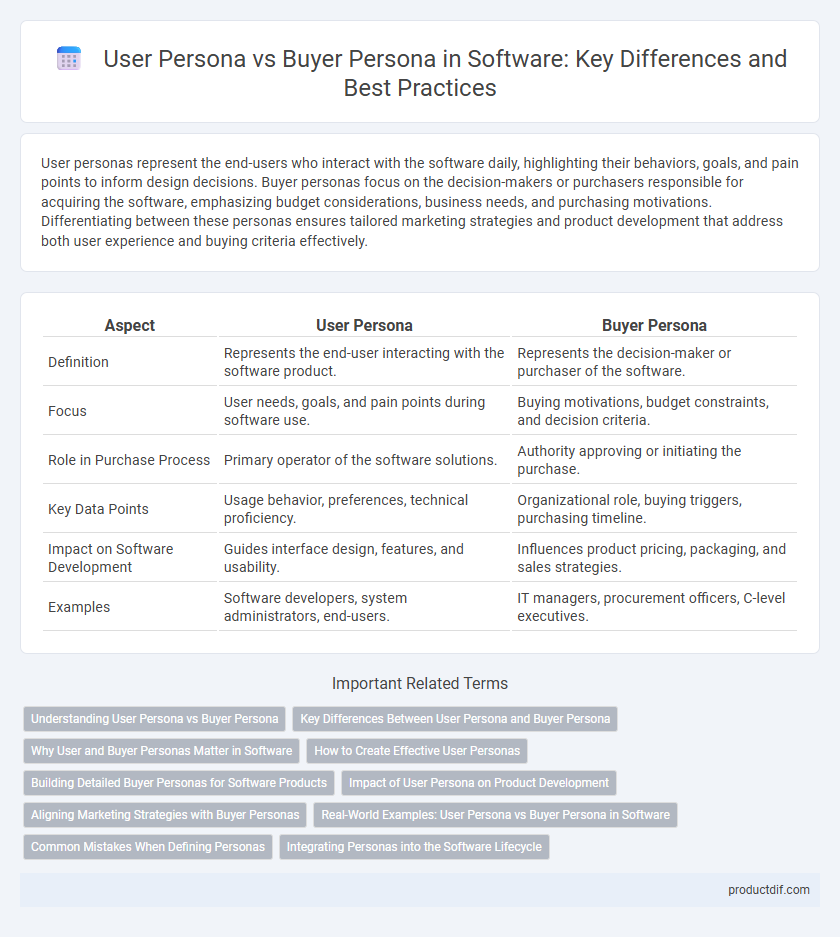User personas represent the end-users who interact with the software daily, highlighting their behaviors, goals, and pain points to inform design decisions. Buyer personas focus on the decision-makers or purchasers responsible for acquiring the software, emphasizing budget considerations, business needs, and purchasing motivations. Differentiating between these personas ensures tailored marketing strategies and product development that address both user experience and buying criteria effectively.
Table of Comparison
| Aspect | User Persona | Buyer Persona |
|---|---|---|
| Definition | Represents the end-user interacting with the software product. | Represents the decision-maker or purchaser of the software. |
| Focus | User needs, goals, and pain points during software use. | Buying motivations, budget constraints, and decision criteria. |
| Role in Purchase Process | Primary operator of the software solutions. | Authority approving or initiating the purchase. |
| Key Data Points | Usage behavior, preferences, technical proficiency. | Organizational role, buying triggers, purchasing timeline. |
| Impact on Software Development | Guides interface design, features, and usability. | Influences product pricing, packaging, and sales strategies. |
| Examples | Software developers, system administrators, end-users. | IT managers, procurement officers, C-level executives. |
Understanding User Persona vs Buyer Persona
User personas represent the end-users interacting with software products, highlighting their goals, behaviors, and pain points for optimal user experience design. Buyer personas focus on decision-makers and purchasers, emphasizing purchasing motivations, budget constraints, and business needs to tailor marketing strategies effectively. Understanding the distinction enables software companies to create targeted solutions that address both user satisfaction and buyer requirements.
Key Differences Between User Persona and Buyer Persona
User personas represent the end-users interacting with the software, emphasizing their goals, behaviors, and challenges to enhance user experience design. Buyer personas focus on decision-makers or purchasers, highlighting their motivations, budget constraints, and purchasing criteria crucial for sales and marketing strategies. Understanding these key differences enables software companies to tailor product development and marketing efforts effectively, aligning user engagement with buyer acquisition.
Why User and Buyer Personas Matter in Software
User personas provide detailed insights into the end-users' needs, behaviors, and pain points, enabling software designers to create intuitive and user-centered interfaces. Buyer personas focus on the decision-makers and stakeholders who influence purchasing decisions, guiding marketing strategies and product positioning to align with business goals. Understanding both personas ensures software development addresses usability while meeting market demands, increasing user adoption and sales success.
How to Create Effective User Personas
Creating effective user personas requires thorough research that includes user interviews, surveys, and behavioral data analysis to capture authentic user needs and motivations. Distinguishing between user personas and buyer personas is crucial, as user personas focus on end-user experience, while buyer personas emphasize purchasing decisions. Incorporating demographic, psychographic, and usage patterns enables software teams to design intuitive interfaces that enhance engagement and satisfaction.
Building Detailed Buyer Personas for Software Products
Building detailed buyer personas for software products requires analyzing demographic data, purchase behavior, and decision-making processes of potential customers. Emphasizing buyer goals, pain points, and software needs enables targeted marketing strategies that resonate with stakeholders responsible for purchasing decisions. Accurate buyer personas enhance product development alignment and improve sales conversion rates by addressing specific organizational challenges.
Impact of User Persona on Product Development
User personas provide detailed insights into the behaviors, goals, and pain points of the software's end-users, enabling development teams to tailor features and interface design to meet real user needs. Incorporating user personas in product development leads to enhanced usability, improved user satisfaction, and higher adoption rates by aligning the product's functionality with actual user workflows and preferences. Understanding user personas reduces development risks by ensuring that product iterations are guided by authentic user feedback rather than assumptions, ultimately resulting in more effective and user-centric software solutions.
Aligning Marketing Strategies with Buyer Personas
Aligning marketing strategies with buyer personas enables software companies to target decision-makers who influence purchasing decisions, such as CTOs or procurement managers. User personas focus on the end-user's workflow and preferences, but buyer personas capture motivations, budget constraints, and approval processes that drive actual sales. Tailoring messaging and campaigns based on buyer personas increases conversion rates by addressing specific business goals and pain points, ensuring marketing efforts resonate with key stakeholders involved in the software buying cycle.
Real-World Examples: User Persona vs Buyer Persona in Software
User personas in software development represent the end-users who interact directly with the product, such as a graphic designer using a photo editing tool, while buyer personas focus on the decision-makers purchasing the software, like a marketing manager selecting a digital asset management system. Real-world examples include Salesforce crafting buyer personas targeting CIOs and IT directors to drive enterprise sales, versus designing user personas for sales representatives using the CRM daily. Understanding both personas enables software companies to tailor product features for usability and create marketing strategies that resonate with purchasing stakeholders.
Common Mistakes When Defining Personas
Confusing user personas with buyer personas often leads to misguided marketing and product development strategies, as user personas emphasize end-user behavior and needs, while buyer personas highlight decision-making and purchasing motivations. Overgeneralizing personas without sufficient data results in stereotypes that fail to accurately represent target audiences, diminishing personalization efforts. Ignoring the distinct goals and pain points between users and buyers prevents effective communication and reduces conversion rates in software sales.
Integrating Personas into the Software Lifecycle
Integrating user personas and buyer personas into the software lifecycle enhances product development by aligning features with real user needs and purchase motivations. User personas guide UI/UX design and usability testing to improve user engagement, while buyer personas inform marketing strategies and pricing models to optimize conversion rates. Synchronizing these personas throughout requirements gathering, development, and post-launch analytics ensures software solutions deliver both customer satisfaction and business value.
User Persona vs Buyer Persona Infographic

 productdif.com
productdif.com